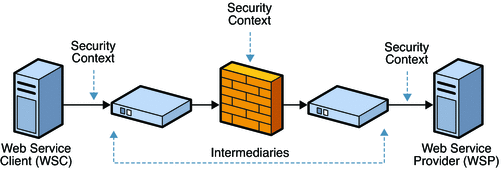About Web Services Security Models
A web service exposes its functionality using the Web Services Framework (WSF). The Web Services Framework defines its interface using Web Service Description Language (WSDL), and communicates using Simple Object Access Protocol (SOAP) and Extensible Markup Language (XML) messages. Although web services enable open, flexible, and adaptive interfaces, this openness create security risks. Without proper security measures in place, a web service can expose vulnerabilities that could allow unauthorized entities access to the enterprise. You can ensure the integrity, confidentiality and security of web services by using a comprehensive security model. In a good security model, web services are secured either point-to-point as provided by SSL/TLS, or end-to-end as specified by the Web Services Security (WS-Security) Framework.
The WS-Security Framework was developed by the OASIS Security committee along with other WS-* specifications such as WS-Trust and WSPolicy. Transport-layer or point-to-point transport mechanisms transmit information over the wire between clients and providers. Transport-layer security relies on secure HTTP transport (HTTPS) using Secure Sockets Layer (SSL). Transport security can be used for authentication, message integrity, and confidentiality. When running over an SSL-protected session, the server and client can authenticate one another and negotiate an encryption algorithm and cryptographic keys before the application protocol transmits or receives its first byte of data. Security is enabled from the time data leaves the consumer until the data arrives at the provider, or from the time the data leaves the provider until the data arrives at the consumer. Sometimes security data transfer can transpire even across intermediaries.
The following figure illustrates a security model that uses point-to-point security.
Figure 11–1 Secure Communication Channel Providing Point-to-Point Security

A drawback to using point-to-point security is that the message is not protected once it gets to its destination. One solution is to encrypt the message before sending using application security.
Using application-layer or end-to-end security, the message is secure even when the message is not in transit. Additionally, in application-layer security, the security information is contained within the SOAP message and the message attachment. This allows security information to travel along with the message or attachment. For example, a portion of the message may be signed by a sender and encrypted for a particular receiver. When the message is sent from the initial sender, it may pass through intermediate nodes before reaching its intended receiver. When this happens, the encrypted portions continue to be opaque to any intermediate nodes, and can only be decrypted by the intended receiver. Message security can be used to decouple message protection from message transport so that the message remains protected after transmission. For this reason, application-layer security is also sometimes referred to as end-to-end security .
The following figure illustrates a security model that uses end-to-end security.
Figure 11–2 Secure Communication Channel Providing End-to-End Security

Application-layer security provides the following: Confidentiality, by encrypting message parts, integrity, by digital signatures , and authentication, by requiring username or X.509 tokens.
- © 2010, Oracle Corporation and/or its affiliates
